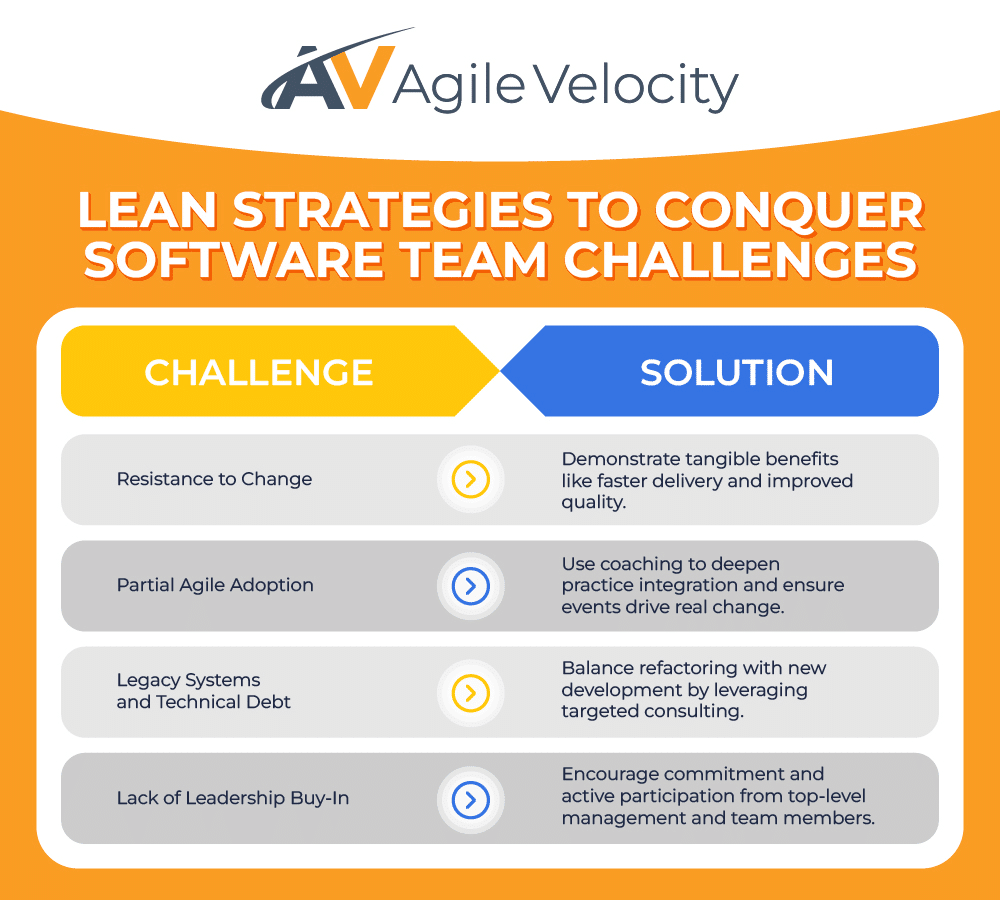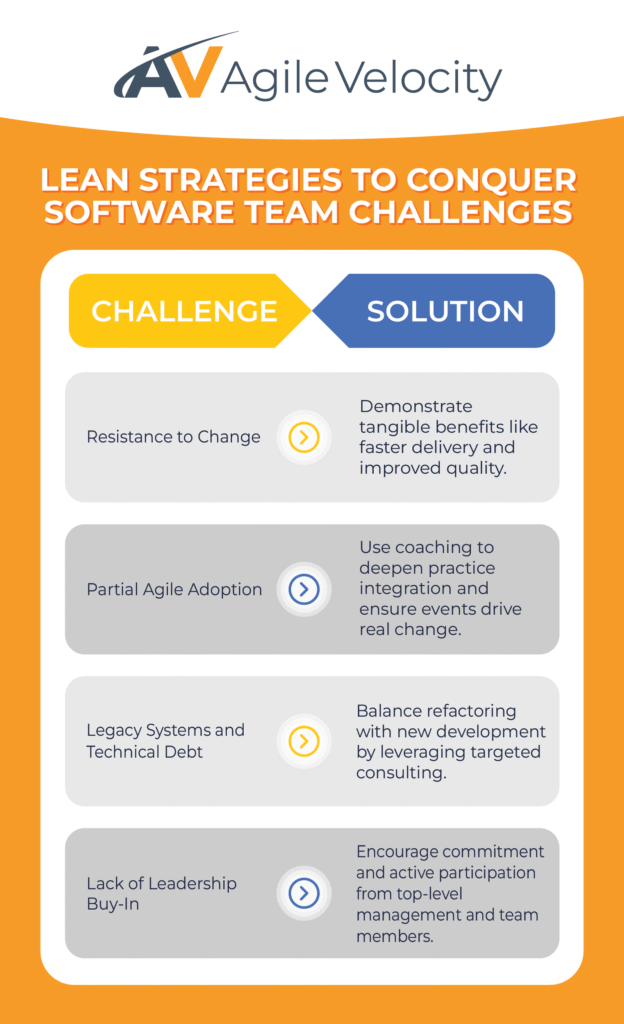Creating true alignment in software teams can transform your organization. Fragmented communication, conflicting goals, and siloed workflows often derail progress—especially in distributed and hybrid settings. However, with the right lean processes, you can connect everyday tasks with strategic objectives, drive collaboration, and deliver consistent value. This guide offers clear, actionable strategies to overcome common obstacles, streamline workflows, and build cohesive teams.
Understanding the Importance of Software Team Alignment
Software team alignment means every team member understands how their work contributes to larger objectives. Without unity, efforts can duplicate, resources can be wasted, and outcomes become inconsistent. This is especially true for distributed and hybrid teams where physical distance complicates real-time collaboration.
When teams are aligned:
- They understand the “why” behind each task,
- They are clear about the value they are producing for the customer and their organization.
- Communication flows freely, reducing ambiguities,
- Strategic goals are clearly connected to day-to-day work,
- Innovation thrives as diverse perspectives merge into creative solutions.
By learning how to balance lean management and Agile, teams can overcome isolation and realign quickly through iterative events like Sprint Planning and Daily Scrum sessions. Moreover, when strategic priorities are well understood, the likelihood of delivering high-quality, valuable products increases dramatically.
Key Strategies for Fostering Transparent Communication
Effective, transparent communication underpins aligned and high-performing teams. It builds trust, fosters accountability, and ensures everyone is on the same page. Key strategies include:
Establish Regular Communication Events:
- Use events such as the Daily Scrum for brief, focused updates.
- Schedule asynchronous updates for remote team members across different time zones.
- Utilize demonstrations not only to get feedback but to align continuously
Leverage Technology:
- Utilize collaborative whiteboards, shared dashboards, and real-time chat platforms.
- Ensure workflows and decision-making processes are visible to every team member.
Encourage Open Feedback:
- Promote a culture where team members freely share ideas and voice concerns.
- Hold Sprint Retrospective and “pulse check” sessions to reflect on progress and address challenges immediately.
Leaders play a crucial role by modeling transparency and creating a safe space for communication, ensuring that every voice is heard and valuable insights drive continuous improvement. In addition, regular updates regarding organizational goals help reduce disconnects between individual contributions and broader business objectives.
Lean Practices and Agile Methodologies for Team Alignment
Lean practices and Agile Methodologies provide the structure and flexibility needed to synchronize team efforts with strategic goals. They reduce waste, highlight high-value tasks, and support iterative feedback for rapid adjustments.
How Scrum Streamlines Alignment
Scrum organizes work into short, focused Sprints where teams:
- Define a clear Sprint Goal during Sprint Planning,
- Use the Daily Scrum to update progress and resolve roadblocks,
- Hold Sprint Reviews and Sprint Retrospectives to reassess priorities and refine processes.
This cyclic approach keeps teams focused and connected, ensuring daily work supports larger business objectives.
Harnessing Kanban for Continuous Flow
Kanban improves team alignment by visualizing work through a continuous flow:
- Tasks are tracked on a Kanban Board under columns such as “To Do,” “In Progress,” and “Done.”
- Work In Progress (WIP) Limits help teams concentrate on the most important tasks.
- The transparent flow of tasks makes it easier to adjust priorities as needs shift.
Lean Portfolio Management
For larger organizations, Lean Portfolio Management connects strategy to execution by:
- Aligning initiatives with the highest business or customer value,
- Encouraging cross-functional collaboration to avoid silos,
- Continuously inspecting and refining processes to optimize outcomes.
Leveraging Path to Agility® Navigator for Team Alignment
Path to Agility® Navigator serves as a practical tool designed to bridge the gap between current practices and desired Agile outcomes. It provides a structured roadmap that helps teams:
- Visualize dependencies and align day-to-day tasks with broader business goals,
- Identify bottlenecks, process inefficiencies, or skill gaps,
- Track progress through clear metrics, ensuring no team member feels lost in the transformation process.
For example, when teams struggle to see how their work propels the organization forward, the Path to Agility Navigator helps map out each stage—linking individual tasks to strategic priorities. The tool delivers actionable insights and clear next steps, making Agile Transformation feel both achievable and practical. Its capacity to continuously monitor progress ensures that teams remain adaptive and responsive to change.
How Consulting Services Drive Alignment Success
Expert business consulting services can support your journey to effective Software Team Alignment by providing tailored solutions that empower teams and remove obstacles.
Business Operations Consulting
This service helps organizations:
- Streamline processes and tailor them to your organization’s unique needs,
- Bridge gaps between departments to ensure that development efforts align with overarching business goals,
- Restructure workflows to reduce bottlenecks and improve clarity in task prioritization.
Agile Coaching
Agile Coaching offers personalized guidance to:
- Instill an Agile mindset across your teams,
- Shift away from hierarchical practices to encourage collaboration and self-management,
- Address challenges—such as technical debt or stakeholder resistance—with informed Agile solutions.
Scaling Agility with SAFe®
Expert consultancy in SAFe helps large enterprises:
- Coordinate multiple teams through Agile Release Trains,
- Define Planning Interval (PI) Objectives that align with strategic goals,
- Maintain consistency in Agile practices across departments.
After the initial introduction, key principles of SAFe can help enterprises scale agility systematically.
Workforce Empowerment Through Training
Comprehensive corporate and public Agile training covers:
- Foundational Agile concepts along with advanced practices,
- Methodologies such as Scrum and Kanban to sustain long-term Agile success,
- Interactive workshops that empower teams to embrace continuous improvement.
Adopting Tools and Methods for Distributed Software Teams

Distributed teams need clear processes to overcome challenges such as asynchronous communication and multiple time zones. To achieve and maintain alignment, consider the following strategies:
Enhance Visibility:
- Use Kanban Boards or project management dashboards to track task progress.
- Ensure every team member can see where tasks are in the workflow.
Regular Touchpoints:
- Schedule frequent Agile events like the Daily Scrum to align on priorities.
- Use video calls or asynchronous updates to include remote team members.
Standardize Communication:
- Establish clear task descriptions and goals.
- Encourage open, culturally sensitive discussions during Sprint Reviews and Sprint Retrospectives.
Overcoming Common Obstacles in Software Team Alignment
Transitioning to Agile practices can be challenging due to inertia, legacy systems, and resistance to change. Common obstacles include:
Resistance to Change:
- Some team members and leaders may be reluctant to move away from traditional methods.
- Demonstrate tangible benefits, such as faster delivery and improved quality, to overcome hesitation.
Partial Agile Adoption:
- Superficial implementation of Agile practices without genuine commitment can stall progress.
- Utilize Agile Coaching to deepen practice integration and ensure that each event—from Sprint Planning to Sprint Retrospective—drives real change.
Legacy Systems and Technical Debt:
- Outdated infrastructure can hinder progress by diverting focus from delivering value.
- Balance refactoring with new development by leveraging targeted Business Operations Consulting.
Lack of Leadership Buy-In:
- Successful transformations require commitment from both top-level management and team members.
- Leaders must openly support Agile initiatives by “walking the walk” and actively participate in alignment efforts.
Building and Sustaining Organizational Agility
Building organizational agility goes beyond team alignment; it is about creating an adaptive culture throughout your enterprise. To build and sustain this agility:
Integrate Agile Transformation:
- Scale Agile methodologies such as SAFe across teams and departments.
- Establish frameworks that facilitate synchronized planning and execution, ensuring that digital initiatives resonate with broader business strategies.
Establish Regular Feedback Loops:
- Implement quarterly strategic reviews and continuous feedback sessions.
- Monitor actionable metrics like team throughput, customer satisfaction, and product quality to gauge progress.
Embed a Culture of Continuous Improvement:
- Empower employees to challenge outdated processes and innovate without fear.
- Encourage a learning environment where iterative feedback and incremental enhancements drive success.
Adapting Agile Practices for Future Success
As technology and market conditions evolve, organizations must adapt their Agile practices to stay ahead. Integrating advanced tools and methodologies refines team alignment. Emerging trends include using data analytics and AI to predict workflow disruptions, optimize task management, and preemptively adjust priorities.
Additionally, continuous learning remains paramount. Organizations should foster an environment where experimentation is encouraged, and lessons from past Sprints inform future strategies. Regular knowledge-sharing sessions, peer coaching, and cross-training initiatives can help bridge skill gaps. As you follow this journey, consider Agile Staffing solutions to scale teams effectively and fill those gaps.
To continue evolving, teams may also consider DevOps practices and cloud-based collaboration. Automated build pipelines, test-driven development, and continuous deployment can boost delivery speed. Tools that incorporate real-time analytics help visualize progress and catch slowdowns early. Meanwhile, investing in leadership training and cultivating peer mentorship fosters a supportive environment for skill growth. Over time, these measures collectively future-proof workflows and maintain readiness for new challenges. Ultimately, your Agile journey becomes an ongoing cycle of learning, adapting, and consistently delivering value to stakeholders.
Measuring Success and Evolving Practices
For sustainable Software Team Alignment, it is essential to measure progress and refine strategies based on data. Establish Key Performance Indicators (KPIs) that resonate with your strategic goals. Quantitative metrics—such as cycle time, team throughput, and defect rates—provide objective evaluation. Equally, qualitative feedback from Sprint Retrospectives illuminates team dynamics, including engagement and communication effectiveness.
Gathering input through employee surveys or personal interviews can yield valuable perspectives about team satisfaction. Such data can help shape actionable improvement steps. Additionally, external benchmarks keep you informed of industry best practices, ensuring that your approach to Agile Transformation remains effective. By continuously refining strategies in this holistic manner, organizations nurture accountability and shared success.
Enhancing Digital Collaboration and Agile Ecosystems
In today’s interconnected world, digital collaboration is central to effective team alignment. Organizations are increasingly investing in digital ecosystems that integrate Agile tools with comprehensive communication platforms. These ecosystems not only streamline workflows but also foster a transparent environment where each team member can contribute ideas and track progress in real time.
Modern platforms can sync project management functionalities with real-time updates, creating a hub for Agile events, task status, and shared documents. This reduces siloed information and keeps distributed team members informed. With consistent use of these tools, teams can highlight successes and address challenges immediately. For instance, explore how Lean and Agile synergy complements digital environments that promote transparency and efficiency.
As new technologies emerge, organizations that invest in collaborative ecosystems are better poised to adapt. Training programs, intuitive interfaces, and ongoing support accelerate tool adoption. By weaving these resources into daily routines, teams can maintain the flexibility and resilience necessary for continuous improvement.
Paving the Path to Unified Agile Excellence
Achieving software team alignment is more than adopting a process—it is about creating a culture of clear communication, shared purpose, and continuous improvement. By leveraging lean and Agile synergy, utilizing practical tools like the Path to Agility Navigator, and engaging with expert consulting services, your organization can bridge the gap between strategy and execution.
If you’re ready to transform your team dynamics and drive consistent, measurable success, explore case studies from real clients or learn more about Agile solutions that can help accelerate your team’s performance. Embrace the journey to true alignment and unlock the full potential of your software teams.





